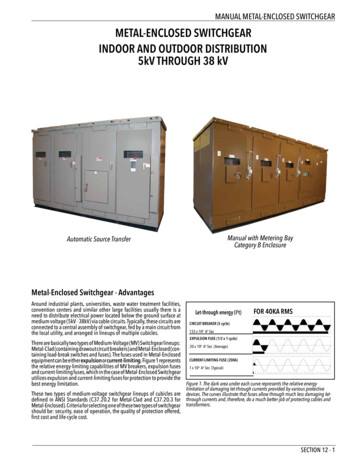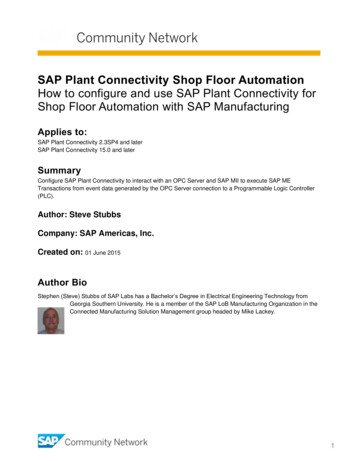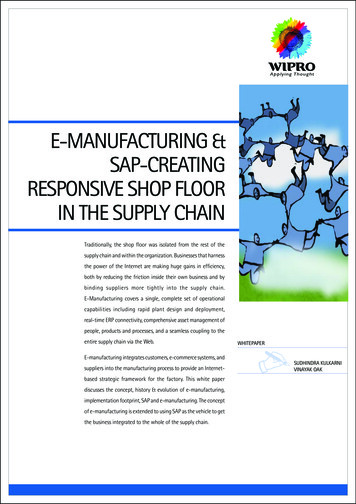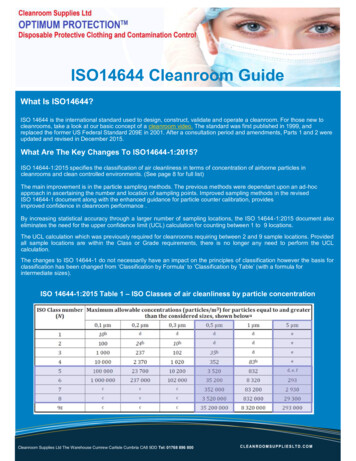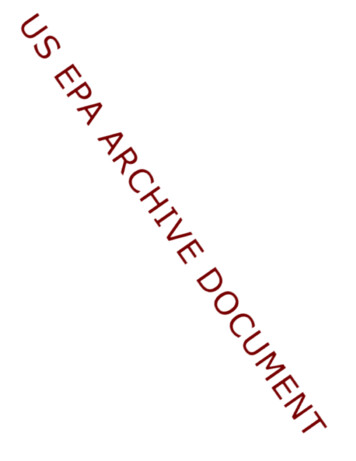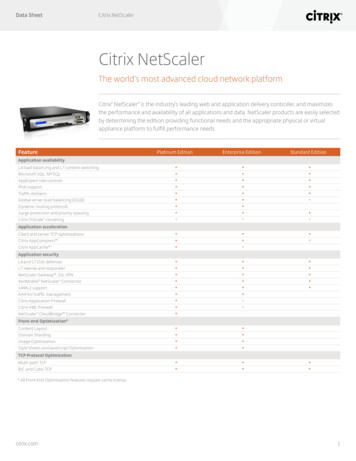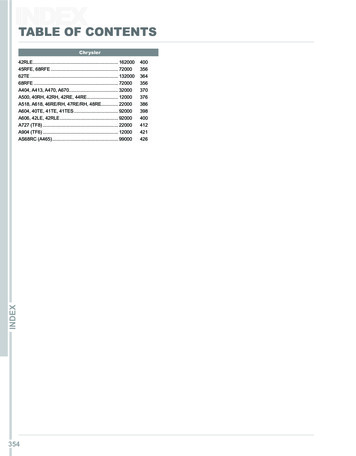
Transcription
Youth Explore Trades SkillsIntroduction to Metal WorkMetal Shop Measurement FoundationsDescriptionThis activity plan provides a basis for instruction of foundational measurement standards andprocedures. It includes the use of imperial and metric measurement tools needed to work in themetal trades.Lesson ObjectivesThe student will be able to: Work with both measurement systems used in metal trades in Canada Demonstrate an essential understanding of proficient measurement tool use Name and operate all basic measurement tools coveredAssumptionsThe teacher should: Be able to explain both the metric and SAE measurement systems Be able to identify and explain precision measurement tool useThe student should: Understand numbers systems Have a basic understanding of what a unit of measurement is Have experience using the metric systemTerminologyDecimal inch: an SAE measurement that is a part of a whole inch represented as a decimalvalue.Fractional inch: an SAE measurement that is a part of a whole inch represented as a fraction.Measurement: assigning a number to represent a length or amount of something based on astandardized system of units.Measuring tape: a flexible ruler with linear measurement markings attached to a springmechanism housed in a case. These may be in imperial or metric units or both.Metric: a system of measurement based on a decimal standard, the global standard inmeasurement. Also known as the International System of Units, abbreviated as SI.This work is licensed under a Creative Commons Attribution-NonCommercial-ShareAlike 4.0 International License unless otherwise indicated.
Metal Shop Measurement FoundationsIntroduction to Metal WorkMicrometer: a gauge that measures small distances/thicknesses between its two faces, one ofwhich is adjusted by a fine screw thread.Ruler: a linear device that has graduations based on either the metric or SAE system intendedfor measuring distance.Ruler graduations: the fixed interval markings along a ruler that represent a progressiveincrease in length measurement.SAE: an acronym for the Society of Automotive Engineers, generally synonymous with the USstandard for the traditional “imperial” measurement system.Unit: a standard quantity in a specific system of measurement.Vernier caliper: a precision measurement device that uses a caliper structure to measure finemeasurements along a Vernier scale.Estimated Time1.5–2 hoursRecommended Number of Students:20, based on the BC Technology Educators’ Best Practices GuideFacilitiesSecondary school metal shop or equivalently equipped technology education shopTools Whiteboard Overhead or data projector Computer Rulers Tape measures Micrometers Vernier calipersMaterials Worksheets For optional activity: samples to measure (variety of sizes and shapes of generalmaterials) Writing implement2Youth Explore Trades Skills
Introduction to Metal WorkMetal Shop Measurement FoundationsResourcesApprenticeship and Workplace Math 10 online: Open School BC, Open Course hp?id 23Teacher-led Activities1. Teacher will introduce each of the four main measurement tools:a. Rulerb. Tape measurec. Micrometerd. Vernier caliper2. Teacher will demonstrate the use and accurate reading of each tool.Student ActivitiesEach of these activities should take no more than 30 minutes.Activity 1: Measuring in Metric Using a Measuring TapeThis is adapted from Open School BC’s Apprenticeship & Workplace Math 10 Module 1Section 1 Assignment Part 1: Measuring in Metric.Activity 2: Measuring in SAE/ImperialThis is adapted from Open School BC’s Apprenticeship & Workplace Math 10 Module 1Section 2 Assignment Part 1: Imperial Units of Length.Activity 3: Vernier Calipers and MicrometersThis is adapted from Open School BC’s Apprenticeship & Workplace Math 10 Module 2Section 1 Lesson B: Measuring DiametersActivity 4: Measuring DiameterThis is adapted from Open School BC’s Apprenticeship & Workplace Math 10 Module 2Section 1 Assignment Part 2: Measuring Circumference and Diameter.Optional Extension ActivityHave a variety of material blanks (common samples) and have students work through individualmeasurement stations. Each station would have a different measurement tool to use and arequirement to use both measurement systems throughout the activity.AssessmentConsider co-creating the assessment criteria with your students at the beginning of the activity/project. You may want to include the following: All worksheet questions are answered correctly and completely.Youth Explore Trades Skills3
Metal Shop Measurement FoundationsIntroduction to Metal WorkStudent Activity 1:Measuring in Metric Using a Measuring TapeInstructionsFor this assignment, you will need a tape measure that shows millimetres, centimetres, andmetres. You will also need two partners.ProcedureStep 1: Measure your and your partners’ heights to the nearest millimetre. Record yourmeasured heights in the appropriate column of the table below.Step 2: Measure your and your partners’ heights to the nearest tenth of a centimetre. Recordyour measured heights in the appropriate column of the table below.Step 3: Measure your and your partners’ heights to the nearest thousandth of a metre. Recordyour measured heights in the appropriate column of the table below.Height(mm)(cm)(m)YouPartner 1Partner 2Have a look at your completed table. Do you notice any patterns? Answer the followingquestions based on the patterns you see. You may use the measurements you recorded asexamples in your explanations.1. Explain how you would change a measurement from millimetres to centimetres and give anexample.Example:4Youth Explore Trades Skills
Introduction to Metal WorkMetal Shop Measurement Foundations2. Explain how you would change a measurement from metres to centimetres and give anexample.Example:3. Explain how you would change a measurement from millimetres to metres and give anexample.Example:Youth Explore Trades Skills5
Metal Shop Measurement FoundationsIntroduction to Metal WorkStudent Activity 2:Measuring in SAE/ImperialInstructionsPlease show all your work.1. Name two objects about one inch in length.AB2.a. At what measures on the ruler are points A and B?A:B:b. How far apart are A and B?3. Nidal lives one block from his school. Nidal paced off the distance and estimates thedistance to be 215 yd. What is this distance in feet?6Youth Explore Trades Skills
Introduction to Metal WorkMetal Shop Measurement Foundations4. The centre lines of vertical framing studs are commonly 16" apart. How many studs would berequired to fasten an 8' length of sheathing? Ignore the width of the studs themselves.(Hint: The left edge of the sheet falls along the centre line of the first stud.)5. A 2 6 is 1½” in thick. How high would a stack of ten 2 6’s be?Express your answer in feet and inches.6. One circuit of the running track at Jon’s school is 440 yd. What fraction of a mile is thatdistance?Youth Explore Trades Skills7
Metal Shop Measurement FoundationsIntroduction to Metal Work7. Norman, who lives in Fort St. John, is planning to visit his friend in Seattle. He will betravelling through Blaine, Washington. The distance from Fort St. John to Blaine is 1221 km.The distance from Blaine to Seattle is 109 mi. To the nearest kilometre, how far is it from FortSt. John to Seattle?8. Monique was asked to quickly estimate the dimensions, in inches, of the cell phone shownbelow.She estimates the cell phone measures approximately 5½” by 2½”.a. How do you think Monique arrived at this estimate?8Youth Explore Trades Skills
Introduction to Metal WorkMetal Shop Measurement Foundationsb. Do you think that Monique’s estimate was a good one? Why or why not?c. What are the actual dimensions, in inches, of the phone? Round your answers to onedecimal place. (Hint: Use the conversion rate of 2.54 cm per inch.)d. Briefly describe a strategy you could use to quickly estimate the conversion betweencentimetres and inches.Youth Explore Trades Skills9
Metal Shop Measurement FoundationsIntroduction to Metal WorkStudent Activity 3:Vernier Calipers and MicrometersRulers, metre sticks, and measuring tapes can give measurements to the nearest millimetre,or to the nearest 0.1 cm. Other measuring instruments can more accurately measure to thenearest tenth of a millimetre, or 0.01 cm, or even to the nearest one-thousandth of a millimetre,or 0.001 mm, depending on their scales.The two measuring instruments you will learn about here are the caliper and the micrometer.Vernier CalipersA Vernier caliper is an instrument used for making accurate linear measurements. It wasinvented by a French engineer named Pierre Vernier in 1613. It is a common tool usedin laboratories and other industries that require precise measurements. Manufacturing ofaircraft, buses, and scientific instruments are a few examples of industries in which precisionmeasurements are essential.Vernier CalipersA Vernier caliper (often called a Vernier or caliper) is a convenient tool to use when measuringthe length of a small object or the outer or inner diameter of a round object like a pipe or hole. AVernier caliper can measure accurately to 0.01 cm, or 0.1 mm.Reading a Vernier caliper is not difficult. Once the jaws of the Vernier are in place, the scalesare set and the reading can be made.There are two scales used for measuring with calipers: SI (metric) and imperial. These twoscales can sometimes be found on the same caliper, one on the top and one on the bottom.When using each scale, the procedure for determining each measurement is slightly different.Only SI calipers will be discussed here.10Youth Explore Trades Skills
Introduction to Metal WorkMetal Shop Measurement FoundationsReading SI or Metric CalipersWhen measuring with a metric caliper, the final measurement will usually be in centimetres (cm).There are three steps needed to read these Vernier calipers. Each step is done independentlyand then the values are all added together.Reading SI or Metric CalipersIn this example, the movable scale is on the bottom of the fixed scale. (It can also be on the top.)The numbers at the top of the fixed scale are in centimetres. Notice that there are tick markson the fixed scale between the numbers. These are in millimetres or tenths of a centimetre.Therefore, there are 10 ticks between the numbers. There are also 10 tick marks on themovable scale.Step 1: Locate the “0” on the movable or sliding scale. Now you need to determine where the“0” is.In this example, the zero is between 2 and 3 cm, so we know our reading will be atleast 2 cm. This is our first part of the reading and can be recorded as follows:2.cmOur goal is to fill in the two blanks to finish the reading.Step 2: Now you must determine the next blank, which represents the tenths of a centimetre.To do this, look carefully at the tick marks between 2 and 3 centimetres on the fixedscale. You can see that the zero line has gone past the second tick but has not yetreached the third tick. So we write down a “2” for the next blank. So our reading nowlooks like this:2.2cmStep 3: You will use the ticks on the moving scale for the final reading. Notice that one of theticks on the moving scale lines up or matches best with a tick mark directly above it onthe fixed scale. In this example, the arrow shows that the third tick matches up mostclosely with the line on the fixed scale. Thus, the value for the third blank must be a 3,and our reading would be:2.23 cmYouth Explore Trades Skills11
Metal Shop Measurement FoundationsIntroduction to Metal WorkNote: It doesn’t matter which line is matched on the fixed scale as we read from the movablescale.Some sites that might help you are the following:http://www.physics.smu.edu/ rnier.html12Youth Explore Trades Skills
Introduction to Metal WorkMetal Shop Measurement FoundationsVernier Calipers PracticeNow try these caliper readings and write down their measurements.1.cm2.cm3.cm4.cm5.cmYouth Explore Trades Skills13
Metal Shop Measurement FoundationsIntroduction to Metal WorkMicrometersMicrometers are another tool that can be used to precisely measure small lengths. In fact,micrometers can make even smaller and more precise measurements than a Vernier calipercan! Micrometers are often used to measure things like the thickness of round or flat items,engine parts, and items being made in a machine shop. While Vernier calipers can measureaccurately to the nearest tenth of a millimetre (0.1 mm), a micrometer can measure to thenearest hundredth of a millimetre (0.01 mm).The illustration shows the standard design of a micrometer. The areas that we will concentrateon are the sleeve (or barrel) and the thimble. The thimble is the moving scale on a micrometer.In an imperial micrometer (top photo), as the jaws open and the space between the anvil andthe spindle gets larger, the thimble turns and goes further down the sleeve. The parts in an SI ormetric micrometer (bottom photo) are all the same, but the scales are different.anvilspindlelockbevelhub orbarrelthimbleratchetMicrometer—Photo by Galushko Sergey 2010This photo shows an enlargement of the sleeve and thimble of the SI or metric micrometer. Thisis the type of photo or diagram that you will be reading the measurements from.Metric micrometer’s sleeve and thimble14Youth Explore Trades Skills
Introduction to Metal WorkMetal Shop Measurement FoundationsReading SI or Metric MicrometersWhen an object is placed in the jaws of a micrometer between the anvil and the spindle, thethimble is turned in order to make both the anvil and the spindle touch the object. As the thimbleis turned, it moves to the left (in the diagram below) and the length of the spindle decreases.To read any length, first look at the top of the spindle reading.
c. Micrometer d. Vernier caliper 2. Teacher will demonstrate the use and accurate reading of each tool. Student Activities Each of these activities should take no more than 30 minutes. Activity 1: Measuring in Metric Using a Measuring Tape This is adapted from Open School BC’s Apprenticeship & Workplace Math 10 Module 1 Section 1 Assignment Part 1: Measuring in Metric. Activity 2: Measuring .

